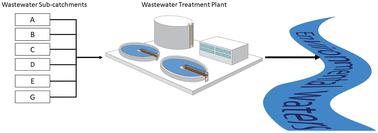当前位置:
X-MOL 学术
›
Environ. Sci.: Processes Impacts
›
论文详情
Our official English website, www.x-mol.net, welcomes your feedback! (Note: you will need to create a separate account there.)
Spatial and temporal variability of micropollutants within a wastewater catchment system
Environmental Science: Processes & Impacts ( IF 5.5 ) Pub Date : 2023-12-13 , DOI: 10.1039/d3em00361b Madison Hattaway 1 , Chris Alaimo 1 , Luann Wong 1 , Jennifer Teerlink 2 , Thomas M. Young 1
Environmental Science: Processes & Impacts ( IF 5.5 ) Pub Date : 2023-12-13 , DOI: 10.1039/d3em00361b Madison Hattaway 1 , Chris Alaimo 1 , Luann Wong 1 , Jennifer Teerlink 2 , Thomas M. Young 1
Affiliation

|
Treated wastewater effluent is a major contributor to concentrations of many anthropogenic chemicals in the environment. Examining patterns of these compounds measured from different catchment areas comprising the influent to a wastewater treatment plant, across many months, may reveal patterns in compound sources and seasonality helpful to management efforts. This study considers a wastewater catchment system that was sampled at six sub-catchment sites plus the treatment plant influent and effluent at seven time points spanning nine months. Wastewater samples were analyzed with LC-QTOF-MS using positive electrospray ionization and GC-QTOF-MS using negative chemical ionization and electron ionization. MS data were screened against spectral libraries to identify micropollutants. As expected, multiple classes of chemicals were represented, including pharmaceuticals, plasticizers, personal care products, and flame retardants. Patterns in the compounds seen at different sampling sites and dates reflect the varying uses and down-the-drain routes that influence micropollutant loading in sewer systems. Patterns in examined compounds revealed little spatial variation, and greater temporal variation. For example, the greatest loads of DEET were found to occur in the summer months. Additionally, groups of compounds exhibited strong correlation with each other, which could be indicative of similar down-the-drain routes (such as a group intercorrelated chemicals that are components of cleaning products) or the influence of similar physicochemical processes within the sewer system. This study contributes to the understanding of dynamics of micropollutants in sewer systems.
中文翻译:

废水集水系统内微污染物的空间和时间变化
处理后的废水是环境中许多人为化学物质浓度的主要贡献者。检查从不同集水区(包括废水处理厂进水)测量的这些化合物的模式,可能会揭示有助于管理工作的化合物来源和季节性模式。本研究考虑了一个废水集水系统,该系统在六个子集水区地点以及跨度九个月的七个时间点对处理厂进水和出水进行了采样。使用正电喷雾电离的 LC-QTOF-MS 和使用负化学电离和电子电离的 GC-QTOF-MS 分析废水样品。根据光谱库筛选 MS 数据以识别微污染物。正如预期的那样,本次展会涉及多种化学品,包括药品、增塑剂、个人护理产品和阻燃剂。在不同采样点和日期观察到的化合物模式反映了影响下水道系统中微污染物负荷的不同用途和下水道路径。检查化合物的模式显示空间变化很小,而时间变化较大。例如,避蚊胺的最大负荷发生在夏季。此外,化合物组之间表现出很强的相关性,这可能表明类似的下水道路径(例如作为清洁产品成分的一组相互关联的化学物质)或下水道系统内类似物理化学过程的影响。这项研究有助于理解下水道系统中微污染物的动态。
更新日期:2023-12-13
中文翻译:

废水集水系统内微污染物的空间和时间变化
处理后的废水是环境中许多人为化学物质浓度的主要贡献者。检查从不同集水区(包括废水处理厂进水)测量的这些化合物的模式,可能会揭示有助于管理工作的化合物来源和季节性模式。本研究考虑了一个废水集水系统,该系统在六个子集水区地点以及跨度九个月的七个时间点对处理厂进水和出水进行了采样。使用正电喷雾电离的 LC-QTOF-MS 和使用负化学电离和电子电离的 GC-QTOF-MS 分析废水样品。根据光谱库筛选 MS 数据以识别微污染物。正如预期的那样,本次展会涉及多种化学品,包括药品、增塑剂、个人护理产品和阻燃剂。在不同采样点和日期观察到的化合物模式反映了影响下水道系统中微污染物负荷的不同用途和下水道路径。检查化合物的模式显示空间变化很小,而时间变化较大。例如,避蚊胺的最大负荷发生在夏季。此外,化合物组之间表现出很强的相关性,这可能表明类似的下水道路径(例如作为清洁产品成分的一组相互关联的化学物质)或下水道系统内类似物理化学过程的影响。这项研究有助于理解下水道系统中微污染物的动态。



























 京公网安备 11010802027423号
京公网安备 11010802027423号